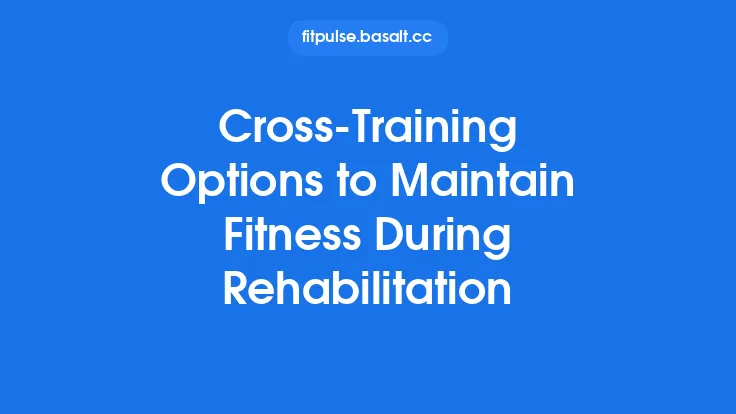Endurance athletes often spend the majority of their training time on the road, trail, or track, but relying solely on running can lead to plateaus, overuse injuries, and mental fatigue. Incorporating cross‑training—activities that differ from primary running but still develop aerobic capacity, muscular strength, and neuromuscular coordination—offers a powerful way to boost performance while preserving joint health and keeping training fresh. Below, we explore the most effective cross‑training modalities for runners, the physiological mechanisms that make them valuable, and practical guidelines for integrating them into a periodized training plan.
Why Cross‑Training Works for Endurance Athletes
Complementary Aerobic Stimulus
Running primarily stresses the lower‑body musculature in a repetitive, high‑impact pattern. Activities such as cycling, swimming, and rowing recruit overlapping but distinct muscle groups and energy systems, allowing athletes to increase total weekly aerobic volume without adding additional impact stress. This “non‑impact aerobic load” can raise VO₂max and improve lactate clearance while giving the musculoskeletal system a reprieve from the repetitive loading of running.
Enhanced Muscular Balance and Joint Stability
Running heavily engages the quadriceps, glutes, calves, and hip flexors. Cross‑training introduces activation of the posterior chain (hamstrings, gluteus maximus, spinal erectors) and upper‑body musculature, promoting muscular symmetry and reducing the risk of muscular imbalances that often precipitate overuse injuries. For example, the pulling motion of rowing strengthens the latissimus dorsi, rhomboids, and biceps, which support proper posture during long runs.
Neuromuscular Variety and Motor Learning
Different movement patterns challenge the central nervous system to recruit motor units in novel ways. This variety improves proprioception, coordination, and overall movement efficiency—attributes that translate into smoother, more economical running form even though the article does not focus on running economy per se.
Psychological Refreshment
Monotony is a common cause of burnout among endurance athletes. Switching to a different modality for a session can renew motivation, reduce perceived training stress, and improve adherence to a high‑volume training schedule.
Core Cross‑Training Modalities
1. Cycling (Road, Mountain, and Stationary)
Physiological Benefits
- Cardiovascular Load: Pedaling at moderate to high intensity (70‑85 % of max HR) elicits a VO₂ response comparable to running at 60‑70 % of VO₂max, allowing substantial aerobic stimulus with minimal impact.
- Muscle Recruitment: Emphasizes the quadriceps, glutes, and hamstrings in a more concentric‑dominant fashion, fostering strength in the hip extensors without the eccentric stress of downhill running.
- Mitochondrial Adaptations: Repeated bouts of 60‑90 minutes at steady state promote mitochondrial biogenesis (upregulation of PGC‑1α) similar to long runs.
Programming Tips
- Base Phase: 2–3 sessions per week, 60–120 minutes at Zone 2 intensity.
- Build Phase: Introduce interval work (e.g., 5 × 5 min at Zone 4 with 3 min recovery) to stimulate lactate threshold improvements.
- Recovery Days: Short, easy rides (30–45 minutes) can replace easy runs, especially after hard key workouts.
2. Swimming
Physiological Benefits
- Full‑Body Aerobic Conditioning: The horizontal position reduces gravitational load, allowing athletes to sustain high heart rates while preserving joint integrity.
- Upper‑Body Strength: Propulsion relies on latissimus dorsi, deltoids, and core stabilizers, balancing the predominantly lower‑body focus of running.
- Breathing Control: Controlled breathing patterns improve diaphragmatic efficiency and can enhance oxygen utilization during later running sessions.
Programming Tips
- Technique First: Allocate the first 10–15 minutes of each session to drills (e.g., catch‑up, fingertip drag) to maximize efficiency.
- Endurance Sets: 4 × 400 m freestyle at moderate pace with 30 seconds rest, progressing to 8 × 400 m as fitness improves.
- Recovery Swims: Light, continuous swimming (20–30 minutes) on rest days can promote active recovery and circulation.
3. Rowing (Ergometer or On‑Water)
Physiological Benefits
- High Power Output: Rowing can generate VO₂max values exceeding 70 ml·kg⁻¹·min⁻¹ in trained athletes, providing a potent stimulus for cardiovascular development.
- Posterior Chain Emphasis: The drive phase heavily recruits glutes, hamstrings, and spinal erectors, complementing the anterior bias of running.
- Core Stability: The need to maintain a neutral spine throughout the stroke enhances core endurance, which supports better running posture.
Programming Tips
- Steady‑State Rows: 30–45 minutes at a consistent split (e.g., 2:00 / 500 m) for aerobic base work.
- Interval Rows: 6 × 500 m at high intensity (split <1:45) with 2 minutes rest to target lactate threshold.
- Technique Emphasis: Begin each session with 5 minutes of “pause drills” (pause at the catch, finish, and finish) to reinforce proper sequencing.
4. Elliptical Training
Physiological Benefits
- Low‑Impact Cardio: Replicates the running gait without the impact forces, making it ideal for athletes managing minor joint soreness.
- Bidirectional Motion: Many machines allow forward and reverse pedaling, engaging both quadriceps (forward) and hamstrings/glutes (reverse).
- Heart‑Rate Control: Easy to stay within precise HR zones, facilitating targeted aerobic work.
Programming Tips
- Zone 2 Sessions: 45–60 minutes at 60‑70 % HRmax, focusing on smooth, consistent motion.
- Hill Simulations: Increase resistance for 3–5 minute “climbs” followed by recovery, mimicking hill repeats without the downhill eccentric load.
5. Hiking and Trail Walking
Physiological Benefits
- Weight‑Bearing Endurance: Provides a moderate impact stimulus while engaging stabilizer muscles (ankles, intrinsic foot muscles) often underutilized on flat surfaces.
- Terrain Variability: Uneven ground improves proprioception and neuromuscular coordination, translating to better foot placement on technical race courses.
- Altitude Exposure: If performed at moderate elevations, can stimulate erythropoietin production, modestly increasing red‑cell mass.
Programming Tips
- Long Hikes: 2–4 hours at a comfortable pace on moderate terrain, preferably with a light pack (5–10 kg) to increase load.
- Technical Sections: Incorporate short, steep climbs or rocky sections to challenge balance and strength.
6. Ski‑Erg (Upper‑Body Cardio)
Physiological Benefits
- Upper‑Body Aerobic Load: Generates high VO₂ values while sparing the lower limbs, useful during periods of lower‑body fatigue or injury.
- Posterior Chain Activation: The pulling motion engages lats, traps, and posterior deltoids, complementing the push‑dominant nature of cycling.
Programming Tips
- Steady‑State: 20–30 minutes at a moderate split (e.g., 1:30 / 500 m).
- Intervals: 8 × 30 seconds all‑out with 30 seconds rest for high‑intensity anaerobic conditioning.
Integrating Cross‑Training into a Periodized Plan
Macrocycle Overview
A typical 12‑month macrocycle for a marathon‑oriented runner can be divided into three phases: Base, Build, and Peak. Cross‑training should be most prominent during the Base phase, gradually tapering as race‑specific running volume and intensity increase.
| Phase | Primary Focus | Cross‑Training Frequency | Typical Modalities |
|---|---|---|---|
| Base (12–20 weeks) | Aerobic development, muscular balance | 2–4 sessions/week | Cycling, swimming, rowing, hiking |
| Build (8–12 weeks) | Threshold and VO₂max work, race‑specific volume | 1–2 sessions/week (mostly low‑impact) | Easy bike rides, recovery swims, elliptical |
| Peak (4–6 weeks) | Sharpening, taper | 0–1 light session (optional) | Short, low‑intensity elliptical or easy swim |
Weekly Microcycle Example (Base Phase)
| Day | Session |
|---|---|
| Mon | Easy run 60 min (Zone 2) |
| Tue | Cycling 90 min (steady Zone 2) |
| Wed | Interval run (e.g., 5 × 1 km @ 10K pace) |
| Thu | Rowing 45 min (steady) + core work |
| Fri | Rest or active recovery swim 30 min |
| Sat | Long run 2 h 30 min |
| Sun | Hiking 2 h (moderate terrain) |
Key Principles
- Maintain HR Zone Consistency: Align cross‑training intensity with the intended running zone to avoid inadvertent over‑training.
- Avoid Redundant Fatigue: Schedule high‑impact running and high‑intensity cross‑training on separate days or with sufficient recovery (≥24 h).
- Progressive Overload: Increase duration or intensity of cross‑training by ~10 % per 2‑3 weeks, mirroring the principle used for running mileage.
- Specificity Balance: While cross‑training provides general aerobic benefits, preserve at least 80 % of total weekly volume as running during the Build and Peak phases to maintain sport‑specific adaptations.
Monitoring Adaptations and Managing Load
Objective Metrics
- Heart‑Rate Variability (HRV): Daily HRV trends can signal whether the cumulative load (running + cross‑training) is excessive. A sustained drop >10 % from baseline may warrant a reduction in intensity or volume.
- Training Impulse (TRIMP): Assign a weighted score to each session (e.g., cycling TRIMP = duration × HR zone factor). Summing weekly TRIMP across modalities provides a holistic view of total cardiovascular stress.
- VO₂max Testing: Periodic lab or field tests (e.g., 5‑minute all‑out on a bike ergometer) can track improvements attributable to cross‑training.
Subjective Measures
- Perceived Exertion (RPE): Use the Borg 6‑20 scale for each session; aim for an average weekly RPE of 13–15 during the Base phase.
- Recovery Questionnaires: Simple daily prompts (e.g., “How rested do you feel?”) help identify early signs of over‑reaching.
Adjustments
- If TRIMP spikes >15 % week‑to‑week: Reduce cross‑training volume by 20 % or replace a high‑intensity session with an easy one.
- If HRV remains depressed for >3 consecutive days: Insert an additional rest day or swap a hard run for a low‑impact activity (e.g., easy swim).
Special Considerations
Altitude and Heat Acclimatization
Cross‑training in a climate-controlled environment (e.g., indoor cycling) can be used to simulate altitude or heat exposure without the added impact stress of running. Using a hypoxic mask or training in a heated room for short intervals can stimulate plasma volume expansion and improve thermoregulatory efficiency.
Injury History
Athletes with a history of tibial stress syndrome, plantar fasciitis, or knee patellofemoral pain often benefit from substituting high‑impact days with low‑impact cross‑training. Emphasize modalities that strengthen the posterior chain and core (rowing, swimming) to address common muscular deficits.
Time Constraints
When training time is limited, high‑intensity interval sessions on the bike or rower (e.g., 4 × 4 min at VO₂max intensity) can deliver comparable cardiovascular stimulus to a longer run in roughly half the time.
Frequently Asked Questions
Q: Will cross‑training make me slower at running?
A: When programmed correctly, cross‑training enhances aerobic capacity, muscular balance, and recovery, all of which support faster running. Detraining only occurs if running volume is reduced below the threshold needed to maintain sport‑specific adaptations, typically during the later phases of a training cycle.
Q: How many cross‑training sessions are optimal per week?
A: For most endurance runners, 2–3 sessions per week during the Base phase provide sufficient stimulus without compromising running volume. This can be reduced to 1–2 sessions as race‑specific mileage ramps up.
Q: Should I prioritize one modality over another?
A: Choose based on personal strengths, injury history, and logistical factors. Cycling is excellent for building leg endurance with low impact; swimming adds upper‑body conditioning and breath control; rowing offers a full‑body power workout. Rotating modalities prevents monotony and ensures balanced development.
Q: Can I use cross‑training to replace a long run?
A: Occasionally, a long bike ride (≥2 hours at Zone 2) can substitute for a long run, especially during recovery weeks or when injury limits running. However, long runs remain essential for specific muscular and biomechanical adaptations required for race distance performance.
Q: How do I gauge the right intensity on the bike or rower?
A: Use heart‑rate zones derived from a recent maximal test or a field test (e.g., 20‑minute time trial). Aim for Zone 2 for steady aerobic work, Zone 3–4 for threshold sessions, and Zone 5 for short VO₂max intervals.
Bottom Line
Cross‑training is not a peripheral add‑on; it is a strategic component of a well‑rounded endurance program. By deliberately selecting low‑impact aerobic modalities—cycling, swimming, rowing, elliptical, hiking, and ski‑erg—runners can amplify their cardiovascular capacity, correct muscular imbalances, and preserve joint health while keeping training mentally engaging. The key to success lies in aligning cross‑training intensity with running zones, integrating it within a periodized framework, and monitoring total load through objective and subjective metrics. When executed thoughtfully, cross‑training becomes a catalyst for faster race times, greater training longevity, and a more resilient, adaptable athlete.





